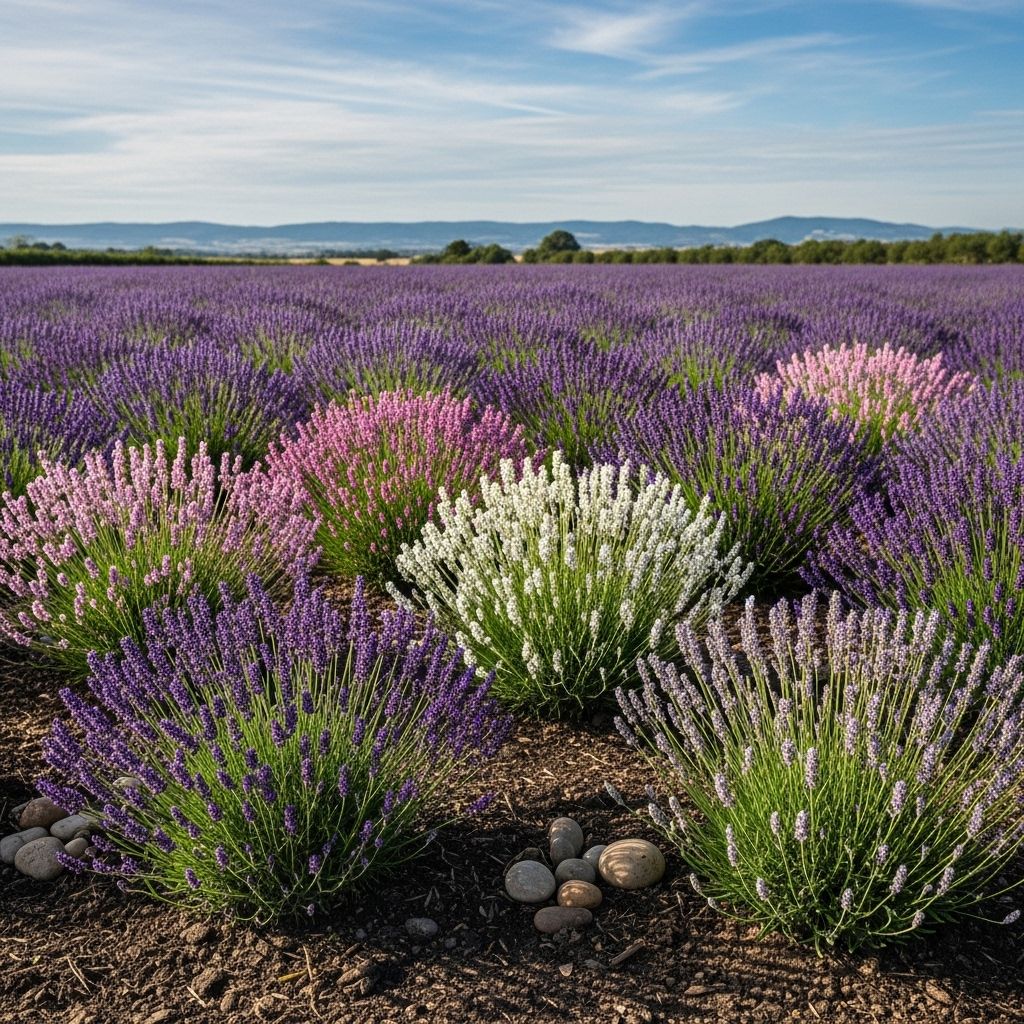Cold Hardy Lavender Varieties: 15 Best For Northern Gardens
Discover the best cold-hardy lavender varieties to thrive in northern climates and enjoy blooms year after year.

Image: HearthJunction Design Team
15 Cold-Hardy Lavender Varieties for Northern Gardens
If you garden in a region where the winters are harsh and the ground freezes, you might assume that growing lavender is a dream out of reach. However, many lavender varieties not only endure but also thrive in cooler climates. This guide will introduce you to 15 outstanding cold-hardy lavender types, their unique features, and how to help them flourish even when the frost bites. We’ll also answer your most common questions and provide expert tips to ensure your lavender garden stays beautiful year after year.
Understanding Cold-Hardy Lavender
Lavender (Lavandula spp.) is best known for its aromatic foliage and vibrant spikes of purple or blue flowers. While native to the warm Mediterranean, some species and cultivars have been bred and selected specifically for resiliency in zones with chilly winters. English lavender (Lavandula angustifolia), in particular, is renowned for its cold hardiness, surviving temperatures down to -20°F (-29°C). In contrast, French and Spanish lavenders are less tolerant but may still perform well in milder cold zones with protection .
- English lavender: The most cold-tolerant, suitable for USDA zones 5–9.
- Lavandin (Lavandula x intermedia): A hybrid with greater size and fragrance, generally hardy to USDA zone 6.
- Site selection, soil prep, and variety choice are all key to lavender’s winter survival.
Cold-Hardy Lavender Basics
Choosing the right lavender and caring for it properly is essential for success in northern gardens. Cold-hardy varieties need full sun, excellent drainage, and careful attention to pruning and protection in late autumn.
- Sunlight: At least 6–8 hours daily
- Soil: Sandy or loamy, with sharp drainage
- Water: Allow soil to dry slightly between waterings
- Fertilization: Use sparingly; excess can increase vulnerability to cold damage
- Winter Protection: Mulch, frost cloths, or windbreaks may help in the coldest areas
15 Best Cold-Hardy Lavender Varieties
Below are fifteen robust lavender cultivars chosen for their proven ability to withstand frigid winters and return with vigor each spring. Each offers a unique blend of color, fragrance, and garden uses.
1. Munstead Lavender (Lavandula angustifolia ‘Munstead’)
‘Munstead’ lavender, introduced in 1916, remains a classic for colder gardens. It matures into a compact mound with rich purple flower spikes, perfect for borders or containers. Its aromatic foliage is prized for culinary uses and crafts, and this variety is hardy in USDA zones 5–9 .
- Bloom period: Early to midsummer
- Height: 12–18 inches tall
- Attributes: Attracts pollinators, edible, drought-tolerant
2. Hidcote (Lavandula angustifolia ‘Hidcote’)
Favored for its deep, almost indigo-purple blossoms and short, tidy growth habit, ‘Hidcote’ is highly prized in northern gardens. Its dense flower spikes dry beautifully, making it a top choice for wreaths and sachets.
- Zone: 5–9
- Height: 12–20 inches
3. Royal Velvet
‘Royal Velvet’ sports long, slender flower spikes with a vivid, bright purple hue. This cultivar is particularly valued for cut and dried flower arrangements and is well-adapted to cool climates.
- Zone: 5–9
- Special use: Excellent for dried crafts
4. Vera (Lavandula angustifolia ‘Vera’)
Often called “True Lavender,” ‘Vera’ is believed to be the original lavender of the English countryside. Renowned for its pure, intensely fragrant oil and robust cold tolerance, it is a solid choice for both ornamental and herbal uses .
- Zone: 5–9
- Special note: Superior for oil production
5. SuperBlue
With compact, mounded growth and dark purple blossoms, ‘SuperBlue’ is excellent for containers and small gardens. Its ability to repeatedly bloom through summer makes it a showstopper in northern perennial beds.
- Height: 10–12 inches
- Uses: Borders, containers
6. Phenomenal (Lavandula x intermedia ‘Phenomenal’)
This hybrid, or lavandin variety, is gaining a reputation for both heat and cold resistance. ‘Phenomenal’ features silvery foliage and large purple flower heads, tolerating winter wetness better than many others.
- Zone: 5–9
- Height: Up to 24–32 inches
7. Grosso (Lavandula x intermedia ‘Grosso’)
One of the best-known lavandin cultivars, ‘Grosso’ boasts long, dense flower spikes with a powerful fragrance. It is a staple of commercial lavender fields and is hardy to lower zone 6 with some protection.
- Height: 24–36 inches
- Harvest: Sought-after for essential oil
8. Melissa
Unusual for its soft pink to pale lavender flowers, ‘Melissa’ stands out among purple-blooming varieties. Its high oil content and subtle color make it a favorite for gardeners seeking something a little different.
- Zone: 5–9
- Special: Pink flowers
9. Betty’s Blue
‘Betty’s Blue’ is a compact, mound-forming cultivar with neat growth and deep blue flowers, perfect for borders and small spaces.
- Height: 18–24 inches
- Bloom: Mid to late summer
10. Arctic Snow
This distinctive, white-flowering English lavender brings a cool elegance to the garden and is exceptionally cold tolerant.
- Zone: 5–9
- Feature: Unique white flowers
11. Blue Cushion
With a compact, low-growing habit and reliable reblooming, ‘Blue Cushion’ makes a great edging plant and works well in rock gardens.
- Height: 12–14 inches
- Zone: 5–9
12. Jean Davis
An English lavender variety noted for its soft, light pink blossoms, ‘Jean Davis’ is prized for culinary uses and its mellow fragrance.
- Zone: 5–9
- Height: 18–24 inches
13. Folgate
‘Folgate’ is an early-blooming English lavender known for its exceptionally sweet scent and abundant, bright blue flowers.
- Height: Up to 24 inches
- Zone: 5–9
14. Buena Vista
This repeat-blooming variety produces masses of dark purple flowers and is perfect for borders or as a fragrant hedge.
- Zone: 5–9
- Feature: Multiple flushes of flowers
15. Sawyers
‘Sawyers’ is a highly fragrant English lavender, forming compact, silver-leaved mounds with classic purple flowers late in the season.
- Height: 16–24 inches
- Bloom: Late summer
Care Tips for Cold-Hardy Lavender
While these lavender varieties are capable of withstanding cold winters, good cultural practices can further boost your plants’ survival and vigor.
- Site Selection: Choose a site with good air circulation and full sun exposure. Avoid frost pockets and poorly drained soils.
- Soil Preparation: Amend heavy soils with sand or gravel for drainage. Raise beds if waterlogging is a concern.
- Watering: Water well after planting, but do not overwater. Established plants are drought-tolerant and dislike wet roots in winter .
- Mulching: Apply a thin layer of gravel or stone mulch around the base to keep soil dry and roots insulated, especially in wet winters.
- Winter Protection: In the coldest zones, cover plants with a frost cloth or evergreen boughs after the ground has frozen to prevent damaging freeze-thaw cycles.
- Pruning: Prune spent flowers and shape plants lightly after blooming. Avoid cutting into woody stems, as this can reduce cold tolerance and vigor .
Frequently Asked Questions (FAQs)
Q: Which lavender is the most cold-hardy?
A: English lavender varieties like ‘Munstead’, ‘Hidcote’, and ‘Vera’ are generally the most cold-hardy, surviving temperatures as low as -20°F (-29°C) in USDA zones 5–9.
Q: How do I protect my lavender in winter?
A: Choose a well-draining site, avoid fertilizing in late summer or fall, cover plants with frost cloth or mulch after the first hard freeze, and prune only the green stems after flowering.
Q: Can I grow lavender in containers in cold climates?
A: Yes. Use large containers with excellent drainage and move them to a sheltered location during winter or insulate pots with straw or bubble wrap. Water sparingly during dormancy.
Q: Are all lavender varieties edible?
A: English lavender varieties are preferred for culinary uses due to their sweeter flavor and lower camphor content. Always confirm a variety’s edibility before use.
Q: Which lavender is best for dried arrangements?
A: ‘Hidcote’, ‘Royal Velvet’, and ‘Grosso’ are all excellent for cut and dried flowers, with strong color retention and fragrance when dried.
Comparison Table: Top Cold-Hardy Lavender Varieties
| Variety | Zone | Height (inches) | Flower Color | Special Attribute |
|---|---|---|---|---|
| Munstead | 5–9 | 12–18 | Purple | Early bloom, culinary use |
| Hidcote | 5–9 | 12–20 | Deep purple | Compact, dries well |
| Vera | 5–9 | 18–24 | Pale purple | True lavender, best for oil |
| Royal Velvet | 5–9 | 18–24 | Bright purple | Dried arrangements |
| Phenomenal | 5–9 | 24–32 | Purple | Hybrid, vigorous growth |
| Grosso | 6–9 | 24–36 | Dark purple | Essential oil staple |
| Melissa | 5–9 | 12–18 | Pale pink | Unusual color, fragrant |
| Betty’s Blue | 5–9 | 18–24 | Deep blue | Compact, neat |
| Arctic Snow | 5–9 | 12–18 | White | Cold-tolerant, unique |
| Blue Cushion | 5–9 | 12–14 | Purple | Low-growing, reblooms |
| Jean Davis | 5–9 | 18–24 | Soft pink | Culinary, fragrant |
| Folgate | 5–9 | 24 | Bright blue | Early, sweet scent |
| Buena Vista | 5–9 | 18–24 | Dark purple | Repeat bloomer |
| Sawyers | 5–9 | 16–24 | Purple | Late bloom, silver foliage |
Conclusion
There’s no need to forego fragrant, pollinator-friendly lavender just because you live in a northern region! With dozens of cold-hardy varieties, you can enjoy the beauty and scent of lavender year after year — in borders, beds, containers, or even for culinary and craft uses. Choose the right cultivar for your zone, plant it in a sunny, well-drained spot, and give your plants a little winter care, and your lavender will thrive for seasons to come.
References
Read full bio of Shinta












